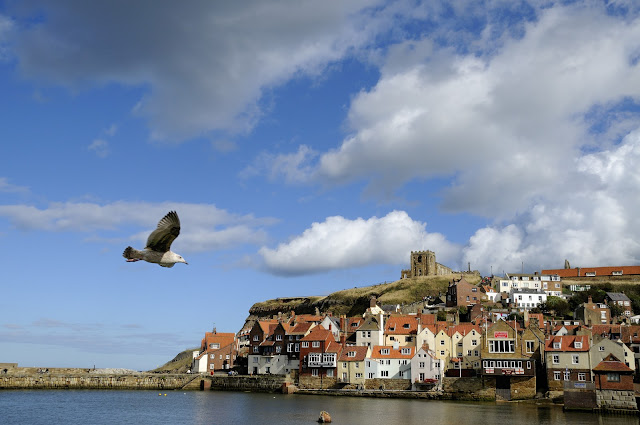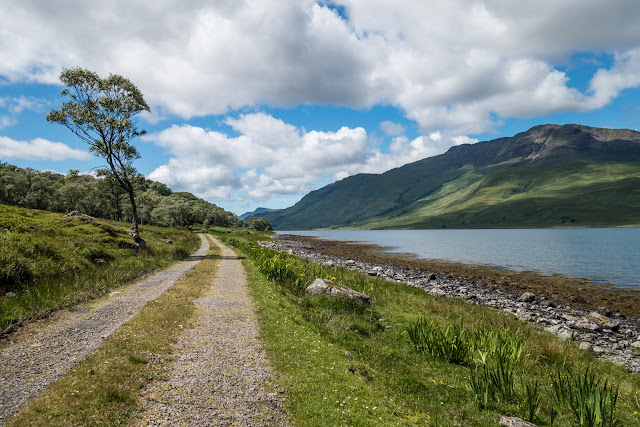Whitby and the famous ruined abbey
Today we planned a trip to Whitby - a place we have not previously visited. Situated on the east coast of Yorkshire at the mouth of the River Esk, Whitby has a maritime, mineral and tourist heritage. Its East Cliff is home to the ruins of Whitby Abbey, where Cædmon, the earliest recognised English poet, lived. The fishing port emerged during the Middle Ages, supporting important herring and whaling fleets, and was where Captain Cook learned seamanship. Tourism started in Whitby during the Georgian period and developed with the arrival of the railway in 1839. Its attraction as a tourist destination is enhanced by the proximity of the high ground of the North York Moors national park and the heritage coastline and by association with the horror novel Dracula.
The earliest record of a permanent settlement is in 656, when as Streanæshealh it was the place where Oswy, the Christian king of Northumbria, founded the first abbey, under the abbess Hilda. The Synod of Whitby was held there in 664. In 867, the monastery was destroyed by Viking raiders. Another monastery was founded in 1078. It was in this period that the town gained its current name, Whitby (from "white settlement" in Old Norse). In the following centuries Whitby functioned as a fishing settlement until, in the 18th century, it developed as a port and centre for shipbuilding and whaling, the trade in locally mined alum, and the manufacture of Whitby jet jewellery.
Today though I believe its mainstay is tourism. We spent a pleasant few hours wandering the compact town and harbour, and then trudged the 199 steps to the top of the East cliff to see the abbey ruins and St Mary's Church.
Looking toward St Mary`s Church across the harbour and with the same photo in B&W. The gull was very obliging as he sailed into the side of the image.
A very `touristy` pirate boat sets out to give you a tour of the area.
The small harbour entrance.
Not sure what this monument represented, but possible workmen in the shipbuilding industry?
So, near the start of the 199 steps ...
Then nearer the top, looking down toward the harbour.
Then to St Mary`s church at the top. The original building was from the Norman period. The nave and transept have 19th-century galleries accessed by internal and external staircases and a three-decker pulpit (Below) which was installed in 1778 and altered in 1847. It retains its 18th-century box pews, some of which are inscribed, "For Strangers Only", and north of the chancel arch is a Jacobean pew.
What a pulpit and gallery!
Love the Box pews, especially the notice on these ones.
The Church of Saint Mary is an Anglican parish church and was founded around 1110, although its interior dates chiefly from the late 18th century. The church was designated a Grade I listed building on 23 February 1954 The church graveyard is used as a setting in Bram Stoker's novel, Dracula. However, he was not lurking about when we visited!
Then onto the magnificent Whitby Abbey ruins. In AD 657 Abbess Hild founded a monastery for men and women at Whitby, on land given by King Oswiu. It was Whitby’s first monastic site and became one of the most important religious centres in the Anglo-Saxon world.
In 664 Whitby hosted a landmark meeting, known as a synod, to decide the date of Easter. By opting to follow the Roman Christian tradition rather than the Celtic one, it was crucial in determining the direction of the English church. The monastery was then abandoned following Danish raids in the 9th century but the Benedictine monk Reinfrid established a new community on the site in 1078. It was suppressed by Henry VIII in 1539 and its ruins are the ones we see on Whitby headland today. The vast shell of the abbey church is a magnificent example of English Gothic architecture.
You can only imagine the splendor of this enormous building when it was at its peak. What most people don't appreciate is that these massive buildings symbolised the collosal wealth of the Church during this period. No wonder Henry wanted some!
A great place to visit and lots of things to see. Well worth a visit.


















Comments